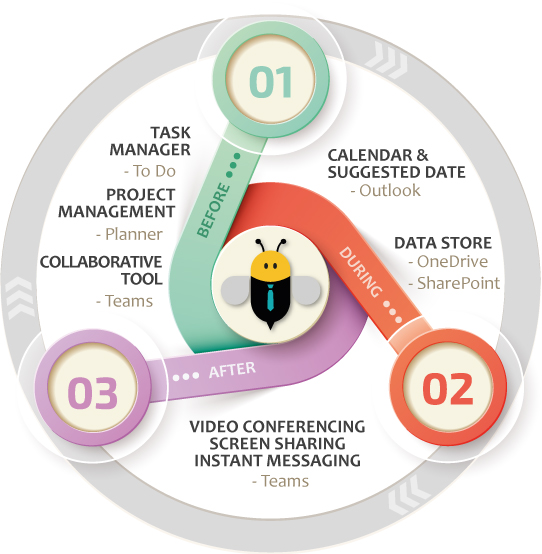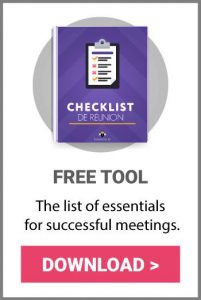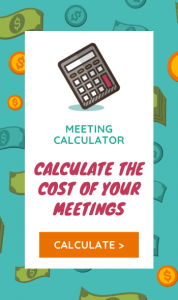Who hasn’t attended an endless meeting with the feeling that they are always getting away from the topic or without knowing the real relevance? Wasting precious time with meetings that are not always productive is very common. Even if we are already overwhelmed, taking a moment to organize it well allows us to save a lot of time. Meeting rhymes with planning!
If you are responsible for organizing a meeting, this article will be very useful for you to optimize them forever! You will find our tips on how to run a more productive team meeting as follows:
Before the meeting
- Establish the purpose of the meeting
- Determine the duration and timing
- Choosing the right meeting format and type
- Structure the meeting with an agenda
- Use the right meeting management tools
During the meeting
After the meeting
Before the meeting: the organization
Establish the purpose of the meeting
To run a more productive, there is a question to ask yourself before: is it relevant to have a meeting about this topic? Our decision tree can help you find the answer.
If the answer is no, let’s remember that the purpose of meetings is to improve operations in the company. Gatherings should not prevent us from doing our work, but rather optimize it.
If the answer is yes, you can now establish the objectives of your meeting with the following questions:
- Why are you holding this meeting?
- What outcome do you want to achieve?
- What information do you want to share or what decisions need to be made?
- Who should participate and what will be their role?
Determine the length and timing
Is this a one-time or recurring meeting? Will it last 15 minutes like a scrum or will it be much longer with planned breaks? By answering these questions, you will be able to establish an adequate duration.
You also need to determine when the meeting will take place and if the timing is convenient for everyone. By using common calendars such as Microsoft Outlook or Google Calendar, we can determine the appropriate date and time based on the availability of each participant.
Then, we need to send an invitation to the people involved. When you create a meeting in Outlook, for example, you can add the link to the video conference or the location. Once the attendee has accepted, it will be added to their calendar resulting in much less chance of absenteeism.
Choosing the right meeting format and type
The two main formats are face-to-face meetings and online meetings. Doing meetings online has become more common since the pandemic. They require higher levels of attention from people but have many advantages.
There are 17 different types of meetings that will suit your context, your established objectives, and also the different departments in your organization.
Here are the most common ones:
Operational meetings or work meetings are used within a team to either inform, problem solve, educate or brainstorm on a particular topic to improve their work.
To increase productivity and commitment daily within your company, the scrum meeting may be a good practice to adopt.
The executive committee is used to bring together executives to conduct the various activities of the company, exchange ideas, and ensure the follow-up of the board’s decisions.
The board of directors (BOD) is used to define policies and guide the management team on strategies by a group of people who represent the financial interests of shareholders.
Structure the meeting with an agenda
Once you have set the objectives, date, and format, you can now plan items you will discuss during the meeting. The best way to establish a structure is to use an agenda. This outline serves as a guideline to reduce non-constructive discussions, avoid oversights and stay within the allotted time.
Important information to put in an agenda are:
1. Basic information (meeting title, date, time, total length, and location)
2. The type of meeting
3. The main purpose of the meeting
4. The topics to be discussed item by item with the length of each
Afterward, you can share the agenda before the meeting so that the participants can better prepare themselves.
To learn more, we recommend our article on how to write an effective agenda for your meetings.
Use the right meeting management tools
Now that you are well prepared, you need to have the proper meeting management tools. The features may differ depending on your needs.
A dashboard that combines planning (before), production (during), and the minutes and follow-ups (after) is a good solution to increase the efficiency of your meetings. To help you with your choice, you can consult our complete guide to help you choose a meeting management solution.
During the meeting: an efficient workflow
It is important to have good facilitation practices during a meeting to reinforce the attention of the participants. If you facilitate meetings, you know that it is easy to lose the focus of the people present, so adopt an energetic and suitable approach.
Don’t hesitate to remind people of the ground rules, such as respecting the time limit, speaking time, etc.

The introduction
Having a productive mindset will shape the dynamics of the meeting. If you take the time to remind people that this meeting is meant to be effective, they will follow the pace. Start by reminding the context and intentions before following the agenda.
The production phase
Next comes the time to go through each item on the agenda. If you are the facilitator, your role is to ensure that the meeting runs smoothly by directing the discussion and making sure that the topics do not get out of hand.
Throughout the meeting, the note-taker must be a good listener. Notes could be added to the agenda as the meeting progresses. This practice keeps track of everything that was discussed and the tasks assigned so that follow-ups can be made later.
A timekeeper is also needed to ensure that you respect the time allocated to the meeting and ideally, the time assigned to each topic or person.
In brief, respecting the framework and having a facilitator who encourages active participation fuels commitment and focuses for everyone.
The conclusion
Finally, the facilitator should conclude the conversation with a summary of what was said and a reminder of tasks and decisions. Notes taken during the meeting should be kept and reviewed for the record.
After the meeting: a well-managed follow-up
To have a successful meeting, the actions taken afterward are equally valuable. You’ve probably made decisions, assigned tasks, and established a plan of action, so be sure to put it into action.
Minutes of meeting
Writing minutes of the meeting is essential to record everything that was agreed upon and exchanged during the meeting. In other words, it is the summary. You can inspire from the agenda and the information gathered, then formalize it into a debriefing.
Psst! Our minutes’ template could be useful for you to write them properly.
Once it is complete, it is time to send it to the participants so that they can consult it. Also, it is important to compile all documentation in one collaborative and secure location for future reference.
Task management
Tasks that have been assigned can be listed with a task management tool or with a to-do list. If you want to improve your task system, we invite you to read our article: How to write the perfect to-do list.

In conclusion, the secret to organizing more productive meetings is in the planning, the structure with an agenda, the adapted animation, the respect of time and roles during the meeting as well as the follow-up thanks to the debriefing and good task management.
We hope to have given you back the enthusiasm for meetings with all our tips to make them more productive, but also more enjoyable!
A passionate web content creator and writer at Beenote, her primary motivation is to create content that can guide organizations looking to optimize their meetings and boards. Giving practical resources to inspire businesses to adopt best practices to become meeting pros. No more wasting time!













0 Comments